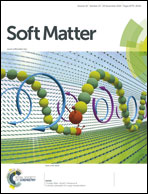Surface structures of poly(methyl methacrylate) films influenced by chain entanglement in the corresponding film-formation solution†
Abstract
The effects of the properties of casting solution on the surface structure of poly(methyl methacrylate) (PMMA) films were systematically investigated. It was observed that the hydrophobicity of PMMA films increased with increasing viscosity of the corresponding polymer solution regardless of the film-formation techniques that were utilized. The ratio of the C–H symmetric stretching vibrations of methylene groups (hydrophobic components, with a peak at 2910 cm−1) to those of the ester methyl groups (relative hydrophilic components, with a peak at 2955 cm−1) from sum frequency generation (SFG) vibrational spectra, A2910/A2955, was used as a parameter to evaluate the structure on the film surface, which was related to the surface wettability of the films. The results showed that A2910/A2955 of cast PMMA films increased linearly with ηsp0.3 (ηsp, the specific viscosity of the casting solution), whereas that of the corresponding spin-coated films showed a linear relationship defined as ηsp0.3E0.26, where E is the average number of entanglement points per molecule (E = Mw/Me). These results indicate that a relative equilibrium conformation on the PMMA film surface, adopted from the perspective of thermodynamics, was easily achieved during film formation, when the conformation of the polymer chains in the corresponding casting solution was close to that in the bulk. For the spin-coated films, the chain entanglement structure in the casting solution was a more important factor for the resulting film to reach a relative equilibrium state, since this structure was in favor of maintaining the pristine conformation in casting solution under centrifugal force during spin-coating. This work may help to enhance the fundamental understanding of the formation of the film surface structure from polymer solution to the resulting solid film, which will affect not only the corresponding surface properties, but also the dynamics of the resulting thin films.


 Please wait while we load your content...
Please wait while we load your content...